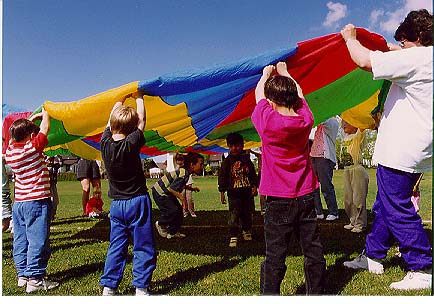

Parachute Play
by Gail Szautner
 A parachute is a wonderful addition to the play equipment in any child care centre. Beautiful and
sometimes calming, a parachute can create soft, whispering sounds or loud, rippling noises,
depending on how quickly it is moved. Parachutes are usually made of brightly coloured,
lightweight nylon and are equipped with strong, reinforced handholds.
A parachute is a wonderful addition to the play equipment in any child care centre. Beautiful and
sometimes calming, a parachute can create soft, whispering sounds or loud, rippling noises,
depending on how quickly it is moved. Parachutes are usually made of brightly coloured,
lightweight nylon and are equipped with strong, reinforced handholds.
Why incorporate parachute play into your program? Because parachute games encourage cooperative, non-competitive play and reinforce turn-taking and sharing. While most gross motor activities for young children develop muscles in the lower body more than the upper torso, parachutes strengthen primarily shoulder, arm and hand muscles. When children work together to make the parachute billow, they also refine perceptual motor skills and develop a sense of rhythm. Language activities can also be incorporated into most parachute games.
Parachutes are a lot of fun for both children and adults to play with, especially in large, grassy areas in the summertime. The opportunities to encourage children's overall development with this exciting activity make it an ideal choice for early childhood programming. Parachutes can be purchased from athletic supply warehouses, early childhood suppliers and army surplus stores (although the latter will be less colourful).
Here are some suggestions for parachute games:
See-Saw Pull -- From a sitting position, have the children pull the chute back and forth in a see- sawing motion.
Make Waves -- While gripping the parachute, everyone moves their arms up and down to make small and large waves.
Ball Roll -- Have the children try to roll balls into the hole in the centre of the parachute.
Chute Lift -- Ask the children to lift the parachute high over their heads and down again. Talk about the soft sounds and breezes that are created. Move the parachute faster and notice the different effects.
Mushroom -- From a standing position, lift the parachute from the ground to waist height, counting one (lift) and two (lift). On three (lift), have everyone raise the parachute high over their heads and then crouch down, pulling the parachute tightly behind them. A mushroom effect is created as the parachute settles.
Parachute Tag -- Lift the parachute high overhead. Call one child's name and have her run (skip, hop, twirl or crawl) to the other side before the parachute comes down and tags her.
One Hand Run -- Have each child hold the parachute with one hand, extending the opposite arm out for balance. Run around in one direction, then change and run around in the other direction. A variation would be to use music as the cue for changing direction (i.e. direction can be changed every time the music stops).
Parachute Run -- Have the children take turns running on the parachute as it lies on the ground,
while the other children make waves. See how long the children can manoeuvre on the waves
before falling down. The length of turns can be determined by songs that the children choose to
sing (i.e. everyone's turn lasts the length of one song).
Gail Szautner is the director of the Children's Choice Child Care Cooperative in Prince Albert,
Saskatchewan.
|
This article first appeared in Interaction published by the Canadian Child Care Federation, Summer, 1994. |

|
|
 |  |  |